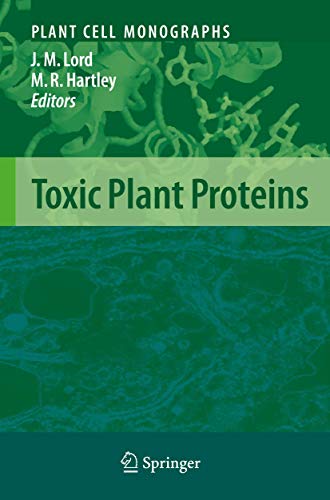Items related to Toxic Plant Proteins: 18 (Plant Cell Monographs, 18)

"synopsis" may belong to another edition of this title.
"About this title" may belong to another edition of this title.
- PublisherSpringer
- Publication date2010
- ISBN 10 3642121756
- ISBN 13 9783642121753
- BindingHardcover
- Number of pages280
- EditorLord J. Michael, Hartley Martin R.
Buy New
Learn more about this copy
Shipping:
FREE
Within U.S.A.
Top Search Results from the AbeBooks Marketplace
Toxic Plant Proteins (Plant Cell Monographs) [Hardcover ]
Book Description Hardcover. Condition: new. Seller Inventory # 9783642121753
Toxic Plant Proteins
Book Description Condition: New. PRINT ON DEMAND Book; New; Fast Shipping from the UK. No. book. Seller Inventory # ria9783642121753_lsuk
Toxic Plant Proteins (Plant Cell Monographs, 18)
Book Description Condition: New. Seller Inventory # ABLIING23Mar3113020218858
Toxic Plant Proteins
Book Description Buch. Condition: Neu. This item is printed on demand - it takes 3-4 days longer - Neuware -Many plants produce enzymes collectively known as ribosome-inactivating proteins (RIPs). RIPs catalyze the removal of an adenine residue from a conserved loop in the large ribosomal RNA. The adenine residue removed by this depurination is crucial for the binding of elongation factors. Ribosomes modified in this way are no longer able to carry out protein synthesis. Most RIPs exist as single polypeptides (Type 1 RIPs) which are largely non-toxic to mammalian cells because they are unable to enter them and thus cannot reach their ribosomal substrate. In some instances, however, the RIP forms part of a heterodimer where its partner polypeptide is a lectin (Type 2 RIPs). These heterodimeric RIPs are able to bind to and enter mammalian cells. Their ability to reach and modify ribosomes in target cells means these proteins are some of the most potently cytotoxic poisons found in nature, and are widely assumed to play a protective role as part of the host plant's defenses. RIPs are able to further damage target cells by inducing apoptosis. In addition, certain plants produce lectins lacking an RIP component but which are also cytotoxic. This book focuses on the structure/function and some potential applications of these toxic plant proteins. 280 pp. Englisch. Seller Inventory # 9783642121753
Toxic Plant Proteins
Book Description Gebunden. Condition: New. Dieser Artikel ist ein Print on Demand Artikel und wird nach Ihrer Bestellung fuer Sie gedruckt. Written by acknowledged experts in the field the book focuses on the structure, function and some potential applications of toxic plant proteinsMany plants produce enzymes collectively known as ribosome-inactivating proteins (RIPs). RIPs catalyze the re. Seller Inventory # 5049782
Toxic Plant Proteins
Book Description Buch. Condition: Neu. Druck auf Anfrage Neuware - Printed after ordering - Many plants produce enzymes collectively known as ribosome-inactivating proteins (RIPs). RIPs catalyze the removal of an adenine residue from a conserved loop in the large ribosomal RNA. The adenine residue removed by this depurination is crucial for the binding of elongation factors. Ribosomes modified in this way are no longer able to carry out protein synthesis. Most RIPs exist as single polypeptides (Type 1 RIPs) which are largely non-toxic to mammalian cells because they are unable to enter them and thus cannot reach their ribosomal substrate. In some instances, however, the RIP forms part of a heterodimer where its partner polypeptide is a lectin (Type 2 RIPs). These heterodimeric RIPs are able to bind to and enter mammalian cells. Their ability to reach and modify ribosomes in target cells means these proteins are some of the most potently cytotoxic poisons found in nature, and are widely assumed to play a protective role as part of the host plant's defenses. RIPs are able to further damage target cells by inducing apoptosis. In addition, certain plants produce lectins lacking an RIP component but which are also cytotoxic. This book focuses on the structure/function and some potential applications of these toxic plant proteins. Seller Inventory # 9783642121753

